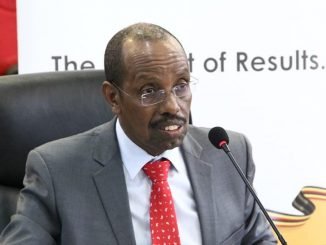
Harare, Zimbabwe | By Michael Wandati | Zimbabwe’s central bank has introduced a novel “structured currency” backed by gold in its efforts to address rampant inflation and bring stability to the nation’s struggling economy.
Dubbed Zim Gold (ZiG), the new currency will have the backing of foreign currencies, gold, and other precious minerals, announced John Mushayavanhu, the Governor of Zimbabwe’s Reserve Bank, during a press briefing in the capital city of Harare on Friday 5, April 2024.
Mushayavanhu further elaborated that ZiG would operate alongside a diverse basket of other currencies.
Additionally, he disclosed the central bank’s plans to implement a market-driven exchange rate.
“With effect from today … banks shall convert the current Zimbabwe dollar balances into the new currency,” he said.
The initiative aims to promote “simplicity, certainty, [and] predictability” in Zimbabwe’s financial landscape, he explained, unveiling the newly minted banknotes spanning eight denominations of between 1 and 200 ZiG.

Coins will also be introduced to overcome the shortage of US coins, which has seen people receive change in sweets, small chocolates and pens.
Featuring illustrations of gold ingots being crafted and Zimbabwe’s iconic Balancing Rocks, reminiscent of the previous currency, the new notes were showcased during the announcement.
Mushayavanhu noted that Zimbabweans have a 21-day window to exchange their old currency for the new ZiG.
Sufficient reserves to support the new Zimbabwe Gold currency – ZiG?
The Zimbabwean dollar has faced a staggering depreciation of nearly 100 percent against the US dollar in the past year.
Officially trading at approximately 30,000 against the US dollar, and at 40,000 on the parallel market according to Zim Price Check, this depreciation underscores the currency’s dire performance.
This sharp decline has significantly contributed to the country’s soaring inflation rate. After reaching triple digits last year, the inflation rate stood at 55 percent in March this year, based on official figures.
Such inflationary pressures exacerbate the plight of Zimbabwe’s 16 million citizens, who already grapple with widespread poverty, high unemployment, and severe drought due to the El Nino weather phenomenon.
The resurgence of skyrocketing prices evokes memories of the hyperinflation crisis of 2008, a period so severe that the central bank issued a 100-trillion-dollar note, now a collector’s item.
Amid these economic hardships, concerns have arisen regarding the sufficiency of Zimbabwe’s reserves to effectively back the new currency. Analysts question whether the currency could be vulnerable to fluctuations in gold prices.

President Emmerson Mnangagwa recently inspected the central bank’s reserves, which Governor Mushayavanhu, appointed earlier this year, claims include 1.1 tonnes of solid gold in local vaults.
Also Read: Why Ugandan shilling is the strongest currency in East Africa
Additionally, the bank holds nearly 1.5 tonnes overseas, along with $100 million in cash and valuable minerals such as diamonds. Mushayavanhu estimates that converting these minerals into gold would add another 0.4 tonnes.
Altogether, the reserves’ value amounts to $285 million, a figure Mushayavanhu asserts is “more than three times cover for the ZiG currency being issued.”
Furthermore, the central bank intends to implement a stringent monetary policy, tethering money supply growth to expansions in gold and foreign exchange reserves.



